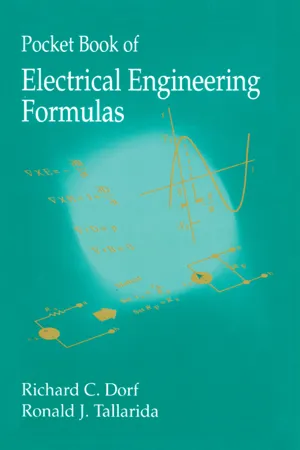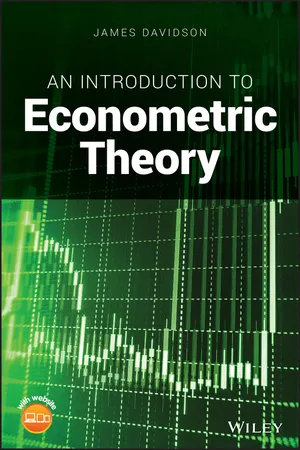Determinant of Inverse Matrix
The determinant of an inverse matrix is the reciprocal of the determinant of the original matrix. In other words, if A is a square matrix and A^-1 is its inverse, then det(A) * det(A^-1) = 1. This property is useful for solving systems of linear equations and understanding the behavior of transformations represented by matrices.
8 Key excerpts on "Determinant of Inverse Matrix"
- eBook - ePub
- Michael Harrison, Patrick Waldron(Authors)
- 2011(Publication Date)
- Routledge(Publisher)
...Determinants DOI: 10.4324/9780203829998-4 2.1 Introduction In Chapter 1 we defined a matrix, saw a few examples of how systems of linear equations and matrices arise in economic and financial applications, and presented the basic operations and rules of matrix algebra, paying attention to the proofs of many of the matrix properties that were stated. We also catalogued a number of special types of matrix that we will encounter later. In this chapter, we introduce the concept of a determinant, which is important in the theory and solution of systems of linear equations. The determinant also provides us with a means of obtaining an explicit formula for evaluating the inverse of a matrix. At a basic level, we can describe a determinant as a real-valued function of a square matrix variable, i.e. a function that associates a real number f (A) with a square matrix A. Formally, we may write f : M → ℝ, where M is the set of square matrices and ℝ is the set of real numbers. However, we require a more precise definition that will also allow us to calculate the numerical value of f (A). Before we give this, we need to be clear on a few preliminary ideas. 2.2 Preliminaries 2.2.1 Permutation The idea of a permutation of some number, r, of integers from the set of integers {1, 2,..., n } is fundamental. As discussed on p. xxiii, a permutation is an ordered arrangement of r of the first n integers. The number of such different permutations, n P r, is given by the general result n P r = n ! (n − r) ! (2.1) defined on p. xxiii, from which it follows that n P n, the number of ordered arrangements of all n integers, is n !, since (n – n)! = 0! ≡ 1. Of these n ! permutations, the typical permutation, i.e. the j th, may be denoted by j 1 j 2... j n. 2.2.2 Inversion An inversion in a permutation of n integers occurs whenever a larger integer precedes a smaller one in the permutation...
- eBook - ePub
- Geoffrey M. Maruyama(Author)
- 1997(Publication Date)
- SAGE Publications, Inc(Publisher)
...Mathematics of calculating inverses is not covered here, for as matrices get larger, the calculations get more complex and more difficult to illustrate. Readers interested in attaining a fuller understanding should consult a book on matrices or matrix algebra (e.g., Marcus & Minc, 1964). For the simplest case, a 2 × 2 matrix, calculation is fairly simple. Consider Matrix A : The determinant is (a × d) − (b × c). then its determinant is (3 × 5) − (2 × 1) = 13. For correlation matrices, the determinant will range between 1 (if all variables are totally uncorrelated) and 0 (if there is perfect collinearity between one or more variables). If a determinant is very close to 0, then there must be substantial relationships between variables, and the data should be examined to look for problems tied to collinearity. Matrices and Rules Finally, a brief reminder about how some common rules apply to matrices: Commutative: A + B = B + A ; however, A × B and B × A are not equal except in special circumstances Associative: A + (B + C) = (A + B) + C ; A (BC) = (AB) C Distributive: A (B + C) = AB + AC ; (B + C) A = BA + CA Distributing Transposes: (AB)′. = B ′ A ′ (note that the order of elements is reversed)....
- eBook - ePub
- Richard C. Dorf, Ronald J. Tallarida(Authors)
- 2018(Publication Date)
- CRC Press(Publisher)
...2 Determinants, Matrices, and Linear Systems of Equations 1. Determinants Definition. The square array (matrix) A, with n rows and n columns, has associated with it the determinant det A = | a 11 a 12 ⋯ a 1 n a 21 a 22 ⋯ a 2 n ⋯ ⋯ ⋯ ⋯ a n 1 a n 2 ⋯ a n n |, a number equal to ∑ (±) a 1 i a 2 j a 3 k ⋯ a n l where i, j, k,…, l is a permutation of. the n integers 1,2,3,… n in some order. The sign is plus if the permutation is even and is minus if the permutation is odd (see 1.12). The 2 × 2 determinant | a 11 a 12 a 21 a 22 | has the value a 11 a 22 − a 12 a 21 since the permutation (1,2) is even and (2,1) is odd. For 3×3 determinants, permutations are as. follows: 1, 2, 3 even 1, 3, 2 odd 2, 1, 3 odd 2, 3, 1 even 3, 1, 2 even 3, 2, 1 odd Thus, | a 11 a 12 a 13 a 21 a 22 a 23 a 31 a 32 a 33 | = { + a 11 ⋅ a 22 ⋅ a 33 − a 11 ⋅ a 23 ⋅ a 32 − a 12 ⋅ a 21 ⋅ a 33 + a 12 ⋅ a 23[. --=PLGO-SEPARATOR=--]⋅ a 31 + a 13 ⋅ a 21 ⋅ a 32 − a 13 ⋅ a 22 ⋅ a 31 } A determinant of order n is seen to be the sum of n! signed products. 2. Evaluation by Cofactors Each element a ij has a determinant of order (n −1) called a minor (M ij) obtained by suppressing all elements in row i and column j. For example, the minor of element a 22 in the 3 × 3 determinant above is | a 11 a 13 a 31 a 33 | The cofactor of element a ij, denoted A ij is defined as ± M ij, where the sign is determined from i and j : A i j = (− 1) i + j M i j. The value of the n × n determinant equals the sum of products of elements of any row (or column) and their respective cofactors...
- eBook - ePub
- Colin Hansen(Author)
- 2018(Publication Date)
- CRC Press(Publisher)
...equal to the sum of the products of the elements and their cofactors along any column or row. For example, the determinant of the (3×3) matrix, A, above can be found by adding the products of the elements and their cofactors along the first row: | A | = a 11 C 11 + a 12 C 12 + a 13 C 13 (A.31) Therefore, the determinant of a large square matrix can be broken up into a problem of calculating the determinants of a number of smaller square matrices. If two matrices, A and B, are square, then: | A B | = | A | | B | (A.32) A matrix is said to be singular if its determinant is equal to zero. A.7 Rank of a Matrix The rank of the (m × n) matrix, A, is the maximum number of linearly independent rows of A and the maximum number of linearly independent columns of A. Alternatively, the rank of A is a positive integer, r, such that an (r × r) submatrix of A, formed by deleting (m – r) rows and (n – r) columns, is non-singular, whereas no ((r + 1) × (r + 1)) submatrix is non-singular. If the rank of A is equal to the number of columns or the number of rows of A, then A is said to have full rank. A.8 Positive and Non-Negative Definite Matrices A matrix, A, is said to be positive definite if x H Ax is positive for all non-zero vectors, x ; if x H Ax is simply non-negative, then A is said to be non-negative definite. For A to be positive definite, all of the leading minors must be positive; that. is: a 11 > 0 ; | a 11 a 12 a 21 a 22 | > 0 ; | a 11 a 12 a 13 a 21 a 22 a 23 a 31 a 32 a 33 | > 0 ; …, etc (A.33) For A to be non-negative definite, all of the leading minors must be non-negative. A.9 Eigenvalues and Eigenvectors Let A be a (square) (n × n) matrix. The polynomial, |λ I – A | = 0, is referred to as the characteristic equation of A. The solutions to the characteristic equation are the eigenvalues of A. If λ i is an eigenvalue of A, then there exists at least one vector, q i, that satisfies the relationship: A q i = λ i q i (A.34) The vector, q i, is an eigenvector of A...
- eBook - ePub
- James Davidson(Author)
- 2018(Publication Date)
- Wiley(Publisher)
...Sometimes the determinant is written as ‘ ’, although the ‘bars’ notation is very well established. The matrix (3.6) is called the adjoint matrix of, written as ‘ ’. 2 Hence, the formula in (3.4) is compactly written as (3.7) In fact, this formulation is perfectly general. Every square matrix, of any order, has a determinant and adjoint defined for it. Moreover, when the determinant is nonzero the inverse always has this form of a scalar product, with the reciprocal of the determinant appearing as the scalar. The determinant of a matrix of higher dimension is a complicated object, and the best way to visualize it is in terms of a recursive rule. A submatrix of is a matrix of smaller dimension constructed by deleting one or more rows and columns from. The minors (or minor determinants) of are the determinants of the square submatrices obtained by deletion of rows and columns. 3 In particular, let denote the determinant of the submatrix obtained by deleting row and column from. Taking, there are of these minors. The cofactors of are then defined as the numbers where equals 1 if is an even number and equals otherwise. If is odd, the sign of the minor is switched, while if is even it is left unchanged. This is called the checkerboard rule, noting that the pattern of pluses and minuses at row and column is like the white and black squares of the checkerboard or chessboard. With these definitions, the general formula for the determinant of () can be given as follows: For any,, (3.8) This is, in many ways, a remarkable formula. The first interesting fact is that it holds true for any value of. This can be used to evaluate any determinant. The second remarkable fact is that the choice of is immaterial. Thinking of the formula as ‘expanding along the row’ of the matrix, with elements appearing in the sum, formula (3.8) yields the same value for any choice of row...
- eBook - ePub
- Arsen Melkumian(Author)
- 2012(Publication Date)
- Routledge(Publisher)
...For example, if matrix A has a dimension of 4 × 4, then where the cofactors are third-order determinants. Evaluation of higher-order determinants can also be reduced to evaluation of third-order determinants. 6.2.1 Properties of determinants The following properties of determinants can be used to simplify the process of evaluating of a determinant. P ROPERTY 6.1 If a matrix has a row (column) of zeros, then the determinant is zero. E XAMPLE 6.24 This property follows immediately from the Laplace expansion (expand | A | by the second column). P ROPERTY 6.2 If a multiple of any row (column) is added to another row (column) of a matrix, then the determinant remains unchanged. E XAMPLE 6.25 P ROPERTY 6.3 A matrix with two identical rows (columns) has a determinant equal to zero. E XAMPLE 6.26 This property is an immediate consequence of Properties 1 and 2. P ROPERTY 6.4 A matrix that has two rows (columns) that are multiples of each other has a determinant that equals zero. E XAMPLE 6.27 Here the second row is the multiple of the first one (R 2 = 5 · R 1). P ROPERTY 6.5 Interchanging two. rows (columns) of a matrix changes the sign, but not the absolute value, of the determinant. E XAMPLE 6.28 P ROPERTY 6.6 The determinant of the transpose of a matrix is equal to the determinant of the matrix (| A ′| = | A |). E XAMPLE 6.29 P ROPERTY 6.7 Multiplying a row (column) of a matrix A by a constant k multiplies the determinant by a factor of k. E XAMPLE 6.30 P ROPERTY 6.8 If A is a triangular or diagonal matrix of order n × n, then the determinant equals the product of the elements of the main diagonal: E XAMPLE 6.31 Determinants have many important applications, including solving systems of linear equations. 6.3 The matrix of cofactors D EFINITION 6.3 Let A be a square matrix of order n × n...
- eBook - ePub
- David A. Bies, Colin H. Hansen, Carl Q. Howard(Authors)
- 2017(Publication Date)
- CRC Press(Publisher)
...The adjoint, Â, is defined as the transpose of the matrix of cofactors of A (see Section A.4): A ^ = [ C 11 C 12 ⋯ C 1 m C 21 C 22 ⋯ C 2 m ⋮ ⋮ ⋮ ⋮ C m 1 C m 2 ⋯ C m m ] (A.40) The inverse, A −1, of the matrix, A, is equal to the adjoint of A multiplied by the reciprocal of the determinant of A : A − 1 = 1 | A | A ^ (A.41) While the definition given in Equation (A.41) is correct, using it to calculate a matrix inverse is inefficient for all by the smallest matrices (as the order of operations increases with the. size, m, of the matrix by m !). There are a number of algorithms that require of the order of m 3 operations to compute the inverse of an arbitrary square matrix (outlined in many of the standard texts and in numerical methods books such as Press et al. (1986); Anton and Rorres (2013)). Note that if the matrix, A, is not square, or if it is singular, such that the determinant is zero, the inverse is not defined. However, for non-square matrices that are non-singular, a pseudo-inverse can be defined, which provides a least mean squares solution for the vector, x, for the problem, Ax = b, where the matrix, A, has more rows than columns, thus representing an overdetermined system with more equations than there are unknowns. In this case: x = (A T A) − 1 A T b (A.42) where the pseudo-inverse of A is A ′ = (A T A) ′1 A T and A ′ A = I. If the matrix, A, is singular, it is possible to define the Moore–Penrose pseudo-inverse, A ′, such that A ′ A acts as the identity matrix on as large a set of vectors as possible. A ′ has the properties: (A ′) ′ = A ; A ′ A A ′ = A ′ ; A A ′ A = A (A.43) If A is. non-singular, then A −1 = A ′. A.10 Singular Value Decomposition If a matrix is non-square, it does not have an eigenvalue decomposition, but it can be written in terms of a singular value decomposition, which can then be used to find the pseudo-inverse, thus allowing the best fit solution to be obtained to an overdetermined system of equations...
- eBook - ePub
- Adil H. Mouhammed(Author)
- 2015(Publication Date)
- Routledge(Publisher)
...For example, Another example would be the identity matrix I. 7. A Symmetric Matrix : A matrix is said to be symmetric if A = A t. 8. A Skew-Symmetric Matrix : This is a matrix whose A is equal to - A t. 9. An Orthogonal Matrix : This is a matrix having the property that AA t = A t A = I. The Determinants The determinant of matrix A is denoted by I A I. To obtain I A I one should understand the following concepts. Minor : The minor IM ij I of an element in a matrix is obtained by deleting the i th row and the j th column ofthat matrix. Example 1: where ij represents the i th row and the j th column respectively. |M 11 | =8, |M 12 | = 4, |M 21 |=7,and|M 22 |=3. Example 2: Find |M ij | for Solution: The values of |M ij | would be, |M 11 |= a 22 a 33 - a 23 a 32, |M 12 |= a 21 a 33 - a 23 a 31, |M 13 | = a 21 a 32 - a 31 a 22, |M 21 |=. a 12 a 33 - a 32 a 13, |M 22 |= a 11 a 13 - a 31 a 13, |M 23 | = a 11 a 32 - a 31 a 12, |M 31 |= a 12 a 33 - a 22 a 13, |M 32 |= a 11 a 23 - a 21 a 13, |M 33 | = a 11 a 22 - a 21 a 12. Example 3: Find |M ij | for Thus, |M 11 |=3×8 - 0 = 24, |M 12 | =1×8-5×0 = 8, |M 13 | = 7-15 = - 8, |M 21 | = 24, |M 22 | = 24 - 45 = -21,. |M 23 | = 21, |M 31 | = -27, |M 32 | = -9, and |M 33 | = 9. Cofactor : The cofactor IC ij I of an element in matrix A is a signed minor. The following formula is used to find IC ij I, Ic ij I=(-1) i+j IM ij I where i and j refer to the i th row and j th column, respectively, and IM ij l are the minors of the elements ofthat matrix. Example 1: Find IC ij I for To use the cofactor formula we need to find IM ij I. These are, |M 11 |=9, |M 12 |=7, |M 21 |=3, and |M 22 |=2...







